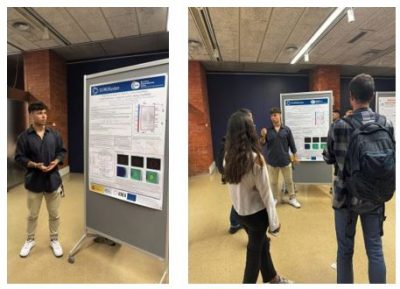
On the 7th and 8th of May, the members of the group Pau Manyer and Hernán Domingo participated in the 11th International BSC Severo Ochoa Doctoral Symposium 2024, presenting their recent work within the framework of their Master’s Thesis projects. In this event, MSc and PhD students and early postdoctoral scientists have an opportunity to gather together and communicate their research projects to the audience, either in the form of oral or poster presentations. In this edition, more than 40 participants from diverse backgrounds could disseminate their research topics and achievements.
On the first day, Hernán presented his poster summarizing the key achievements reached during his internship at the Barcelona Supercomputing Center (BSC). He has worked on the development of MAXWEL, a module responsible for simulating a propagating electromagnetic wave inside a plasma using a Finite Element Method (FEM). This software solves the Helmholtz equation in a 2D domain for a transversal electric and a transversal magnetic polarized wave. He has achieved the simulation of an isotropic and anisotropic dielectric scatterer, and expects to implement the correct parametrization for a cold plasma soon. More upgrades to the module are planned for the near future, such as adapting the geometry of the domain to a tokamak-like shape or scaling to a 3D solution for the full reactor. The final goal is to implement this module into ALYA, together with its other subroutines, to be able to fully simulate the multi-physics phenomena of a nuclear fusion reactor.

On the other hand, Pau has taken some distance from his previous work on the AORSA 3D code and started a new project developing EQUILI, a Grad-Shafranov equation solver using Finite Elements, of which he presented its results and algorithm work-flow during the second day of the symposium. Similarly to Hernán’s MAXWEL, EQUILI will be implemented as a new module into ALYA and will be responsible for computing the equilibrium configuration of the plasma in a tokamak device (axi-symmetric). Whereas MAXWEL is based on a classical FEM scheme, EQUILI has been developed using a method with embedded geometry known as CutFEM, which offers interesting advantages when solving problems where the geometries and regions may change and deform.

Both MAXWEL and EQUILI arise from the interest of the BSC Fusion group to develop robust codes aiming towards an ultimate goal: simulating the dynamics inside a fusion reactor in the supercomputer MareNostrum, hosted at BSC.
Such a project could be based on the coupling of three new modules in ALYA: MAXWEL, EQUILI and MHD, the last one being responsible for solving the magnetohydrodynamics of a plasma. The equilibrium solution obtained from EQUILI shall be used as the initial guess for MHD, on which perturbations will be applied. Finally, for any given configuration obtained throughout the simulation, the electromagnetic wave propagation inside the plasma could be computed using MAXWEL.
